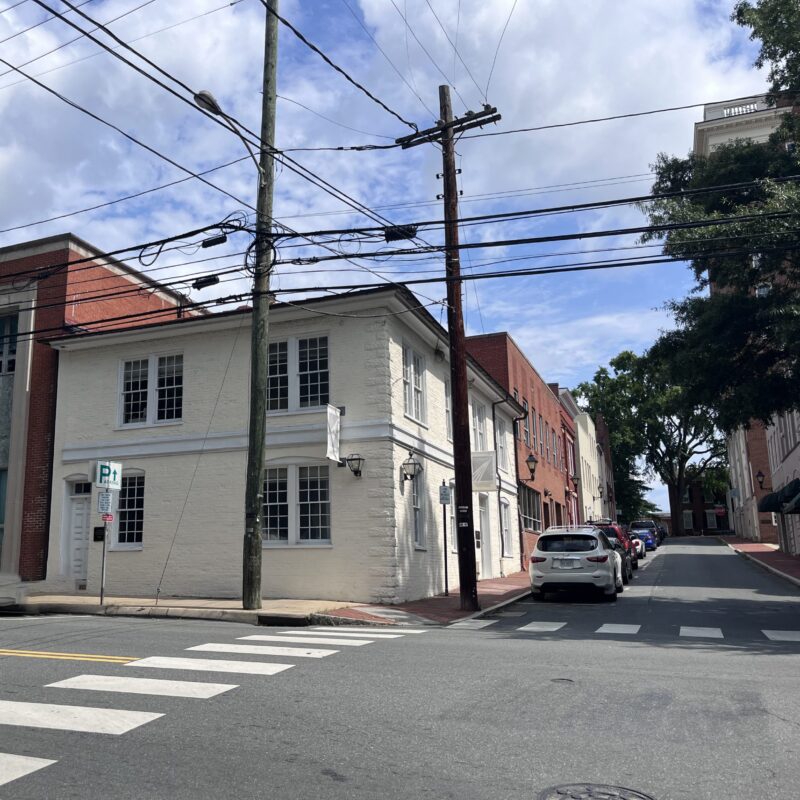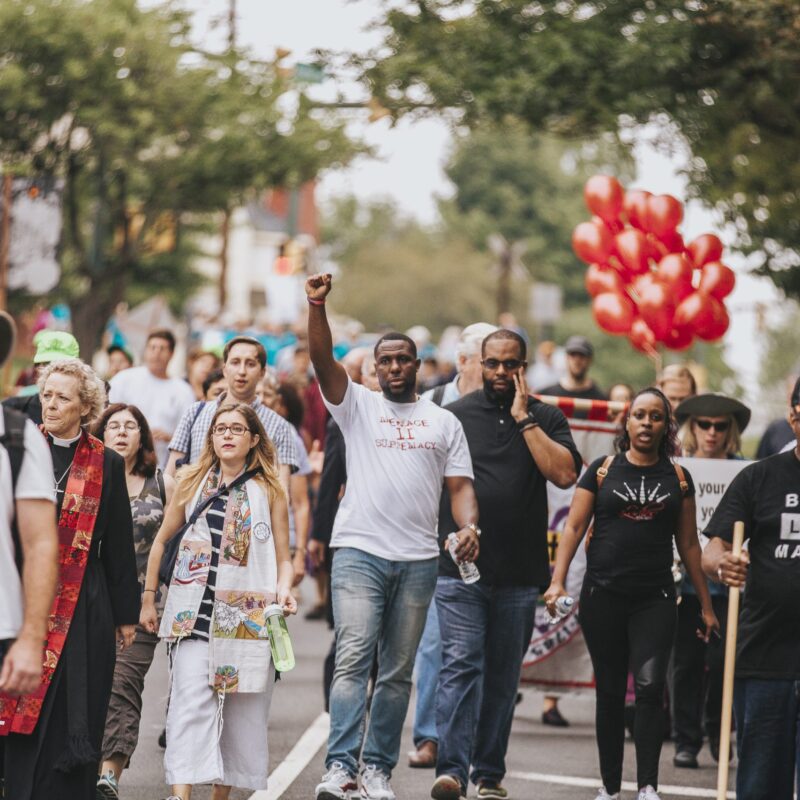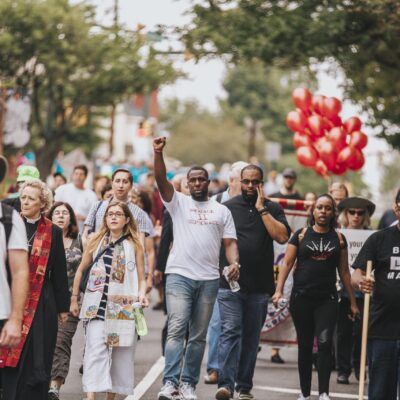| More 2007 year in Review
The year of the blueprint (not the bulldozer) Rape, murder, kiddie porn and more Nukes, Fines, C.A.R.S., Pigs and parks |
The area’s biggest employer continued its $3 billion quest to help raise its rankings, while leaving some question marks in top admin positions and a new human resources system.
Show me the money: The capital campaign marches on
Mr. Jefferson’s university has long prided itself on its academic excellence, but over recent years, it has pushed hard to break into the highest tier of national universities, public or private. It’s been hard going—U.S. News and World Report only moved UVA up one spot, to No. 23, this August. But in 2007, UVA continued with its old plans—and started drawing up new ones, like the ominously titled Commission on the Future—to break into the Top 10 nationally, looking for top hires, building fancy facilities and raking in lots of dough.
 Frank Batten (second from left) gave $100 million for a leadership school, the biggest single donation in UVA history. No wonder higher ups John "Dubby" Wayne (left), John Casteen and Gene Block (right) were close to his side. |
In the midst of a $3 billion capital campaign, the University has raised $1.41 billion as of the end of October, and so far it hasn’t been particularly picky about where the money is coming from. In February, UVA announced a $25 million donation from Philip Morris USA. And in October, University President John Casteen ceremonially broke ground on a new building
for the Curry School of Education with Dan Meyers, who has given $23 million to Curry. But Meyers’ name was in the news for other reasons, as The New York Times exposed his company’s part in the student loan scandal.
The crowning achievement of this year’s capital campaign, however, was the largest donation in school history: $100 million from Frank Batten. A noticeably aged Batten gave the money for a school of leadership, the first new school at UVA since the Darden business school was started in 1954.
But some students this year started to question the price of free money when they learned that Bob Sweeney, UVA’s senior vice president for development and public affairs, was in line for one of the Pavilion houses on the Lawn. The earnest students saw Sweeney’s residence as a reward for his fundraising success, and in March put "For Sale" signs around his future Pavilion abode.
Help wanted: Arts and Sciences deanship goes unfilled
But if Sweeney doesn’t raise money, who will? Increasingly part of the job of upper echelon administrators has been to solicit for funds, but this year saw a long list of vacancies in top spots.
 A good dean is hard to find: Former Arts and Sciences dean Ed Ayers announced he was leaving in the fall of 2006, but UVA still hasn’t made a long-term hire. |
Early this year, UVA had to go looking for a new provost after Gene Block, who had held the job since 2001, announced he was leaving to become chancellor at UCLA. That gaping hole was filled relatively quickly, as UVA tapped the med school dean, Arthur "Tim" Garson, to move up in April.
But no such luck in the search for a new dean of Arts and Sciences. The position is still unfilled more than 13 months after the much beloved Ed Ayers, who had helmed the South Lawn ship through rocky seas of fundraising and architectural bickering, announced he was leaving the post to take the presidency at the University of Richmond. The first "international" search failed to produce an Ayers successor, though UVA held its cards to its chest right up until July 2, when Ayers started at Richmond. The University was deanless for a day, until Karen Ryan, a professor of Slavic languages and literature, was appointed interim dean.
Ryan said she’s not interested in the job long term, and UVA said it would conduct another "extensive" search. What’s so hard about filling one of the most prestigious posts in academia? Part of the problem could be serving the two masters of arts and sciences—it’s hard to appease both the lit fiends and the lab rats—but the job also demands "the capacity to raise a great deal of money in a relatively short time," in the words of Casteen.
The Arts and Sciences deanship isn’t the only one left to fill for UVA. After losing Garson to the provost’s chair, the med school has yet to make a long-term appointment. The law school is looking for a dean to replace John Jeffries, who’s stepping down in July. And Jeanette Lancaster, who’s been nursing school dean for 19 years, has announced she won’t return to the job next summer.
Staff keeps close watch on HR changes
Staff issues turned down to a simmer after some rancorous years, but the pot’s ready to boil depending on the University’s next move.
The Staff Union at UVA, led by its president, Jan Cornell, kept a close watch through the University’s push for charter restructuring, the new deal that UVA and some select other higher ed institutes worked out with the state for increased autonomy. One element Cornell has been particularly wary about is the introduction of a new UVA human resources system. All staff had been state employees, but new hires as of July 2006 are automatically part of the new system. Older employees can opt into the new system, but once they do, they can’t opt out. And Cornell is concerned that salaries, raises and benefits guaranteed state employees won’t translate in the new system.
The thing is, that system still hasn’t been unveiled. Susan Carkeek, appointed vice president of HR this year, has held some staff meetings and conducted a survey in order to help her put together that system.
"I like my job here at UVA," Brad Sayler, an outspoken employee in the civil engineering department, said during one such meeting held in September. "I just don’t like the way employees get treated around here a lot of the time." Sayler echoed those comments to local state legislators in December, asking whether any of them would support a bill to give workers the right to collective bargaining. State Senator Creigh Deeds noted that that would be dependent on the right to strike, and said the General Assembly is not about to grant that to workers any time soon.
A lingering staff issue from 2005 moved up a layer in the judicial system this year, as Dena Bowers’ $1 million wrongful termination lawsuit against UVA went from the U.S. Circuit Court to the U.S. Court of Appeals. Bowers claims she was fired for inadvertently forwarding an e-mail critical of charter restructuring to a large group of employees in 2005. UVA contends that her firing had nothing to do with censoring her speech. Judge Norman K. Moon threw out most of the substantive arguments of the suit after a March hearing in U.S. Circuit Court, and so her attorney, noted civil rights lawyer Deborah Wyatt, appealed the decision.
But that didn’t stop UVA from going after Bowers and her attorney, seeking sanctions and accusing them of misconduct in the case. A federal magistrate judge sided with UVA against Wyatt, fining her $4,150. Wyatt has also appealed that ruling.
The year of moderate athletic success
Much like the Mother Hoo, UVA’s major sports teams also managed to earn rankings in the 20s. While in recent years it’s been up to soccer, lacrosse, tennis and baseball to bring home the championships, this year both the men’s basketball teams and the football team surprised the ACC with solid play. Playing their first season in the $130 million John Paul Jones Arena, Sean Singletary and J.R. Reynolds must have liked the new rims. The backcourt tandem led the Hoos to surprise victories over Arizona and Duke, and earned the team an ACC co-championship and the first NCAA birth since 2001.
 J.R. Reynolds, who graduated in May, was crucial to UVA’s unusual basketball success in the spring. |
After an ignominious start out in Wyoming, the football team managed to stumble upon victory after victory, setting an NCAA record for the number of close wins and earning the first New Year’s bowl bid since 1994. (Though not many more will be forthcoming from bowl officials no matter how many wins if UVA can’t get more fans down to Jacksonville for the Gator Bowl.)
Other sports had closer calls with NCAA championships—the women’s lacrosse and rowing teams were runners up, and the baseball team had home field advantage in the NCAA tournament—but the only Cavaliers to win a national title this year were Somdev Devvarman, who won the tennis single’s championship, and the Varsity Four of the women’s crew team.
Clothes and cartoons: Fighting over the big stuff
While 2007 didn’t have the highly publicized racial epithets of past years, a couple of race controversies brewed this year that highlighted the sensitivity of the topic. A dress code debacle brewed this spring, after the restaurant/nightspot Jabberwocky began prohibiting plain white t-shirts, baggy pants, brimless hats, sweatpants and camouflage, a checklist many thought targeted African Americans. Jabberwocky owners eventually agreed to step back the code (though they later changed the name of the place to Three).
 This Cav Daily cartoon caused its own fight, leading to the firing of its artist. |
Then, in September, a Cavalier Daily cartoon, "Ethiopian Food Fight," drew national headlines. After pressure from 200 protestors, Cav Daily management fired its creator, Grant Woolard (whom previous editors had stuck by when he was attacked by Bill O’Reilly). Staff cartoonists quit in protest, though most came back to their jobs. C-VILLE cartoonists weighed in, most saying he shouldn’t have been fired but that he also didn’t draw a funny cartoon.
Findings 2007
The University has well learned the lesson that if you talk to neighbors, they won’t hate you (and therefore won’t complain to City Council), as demonstrated by the lack of complaint over the groundbreaking of the South Lawn project. Recognizing mid-term graduates with a ceremony might encourage them, which helps explain why UVA doesn’t hold one. Doctors at the University perform a lot of angioplasties. UVA students occupy 53 percent of rental units. It’s O.K. for faculty members to sit on some Board of Visitors committees, but not others. More oral sex could be leading to increased urethritis. Fifty-one percent of students still believe that kicking out honor code offenders should be the only available punishment. One in five locals work at the University. UVA is adding about 150 students per year, which would mean 90 new employees per year if it keeps the same ratio to students. Among freshmen, 67 percent own iPods and only four of them don’t own laptops. The UVA Foundation owns about 5,000 acres in the county. UVA acknowledges that slaves helped build the Lawn.
C-VILLE welcomes news tips from readers. Send them to news@c-ville.com.





